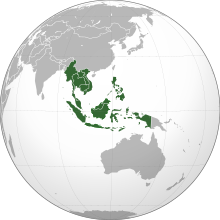
The region of Southeast Asia is considered a possible place for the evidence of archaic human remains that could be found due to the pathway between Australia and mainland Southeast Asia, where the migration of multiple early humans has occurred out of Africa.[1][2][3] One of many pieces of evidence is of the early human found in central Java of Indonesia in the late 19th century by Eugene Dubois, and later in 1937 at Sangiran site by G.H.R. van Koenigswald.[4] These skull and fossil materials are Homo erectus, named Pithecanthropus erectus by Dubois and Meganthropus palaeojavanicus by van Koenigswald.[5] They were dated to c. 1.88 and 1.66 Ma, as suggested by Swisher et al.[6] by analysis of volcanic rocks.[7]
- ^ Morley, Mike W. (2017). "The geoarchaeology of hominin dispersals to and from tropical Southeast Asia: A review and prognosis". Journal of Archaeological Science. 77: 78–93. Bibcode:2017JArSc..77...78M. doi:10.1016/j.jas.2016.07.009.
- ^ Bellwood, Peter (1987-06-01). "The prehistory of Island Southeast Asia: A multidisciplinary review of recent research". Journal of World Prehistory. 1 (2): 171–224. doi:10.1007/BF00975493. ISSN 0892-7537. S2CID 161958865.
- ^ Demeter, Fabrice; Shackelford, Laura L.; Bacon, Anne-Marie; Duringer, Philippe; Westaway, Kira; Sayavongkhamdy, Thongsa; Braga, José; Sichanthongtip, Phonephanh; Khamdalavong, Phimmasaeng (2012-09-04). "Anatomically modern human in Southeast Asia (Laos) by 46 ka". Proceedings of the National Academy of Sciences. 109 (36): 14375–14380. Bibcode:2012PNAS..10914375D. doi:10.1073/pnas.1208104109. ISSN 0027-8424. PMC 3437904. PMID 22908291.
- ^ Corvinus, Gudrun (2004-01-01). "Homo erectus in East and Southeast Asia, and the questions of the age of the species and its association with stone artifacts, with special attention to handaxe-like tools". Quaternary International. 5th International conference on the cenozoic evolution of the Asia-Pacific environment. 117 (1): 141–151. Bibcode:2004QuInt.117..141C. doi:10.1016/S1040-6182(03)00124-1.
- ^ Corvinus, Gudrun (2004-01-01). "Homo erectus in East and Southeast Asia, and the questions of the age of the species and its association with stone artifacts, with special attention to handaxe-like tools". Quaternary International. 5th International conference on the cenozoic evolution of the Asia-Pacific environment. 117 (1): 141–151. Bibcode:2004QuInt.117..141C. doi:10.1016/S1040-6182(03)00124-1.
- ^ III, C.C. Swisher; Curtis, G.H.; Jacob, T.; Getty, A.G.; Suprijo, A.; Widiasmoro (1994-02-25). "Age of the earliest known hominids in Java, Indonesia". Science. 263 (5150): 1118–1121. Bibcode:1994Sci...263.1118S. doi:10.1126/science.8108729. PMID 8108729.
- ^ Marwick, Ben (2009-06-01). "Biogeography of Middle Pleistocene hominins in mainland Southeast Asia: A review of current evidence". Quaternary International. Great Arc of Human DispersalGreat Arc of Human Dispersal. 202 (1–2): 51–58. Bibcode:2009QuInt.202...51M. doi:10.1016/j.quaint.2008.01.012.
